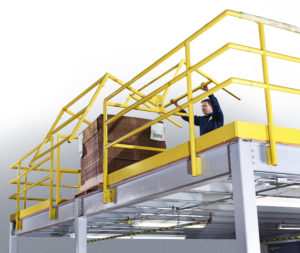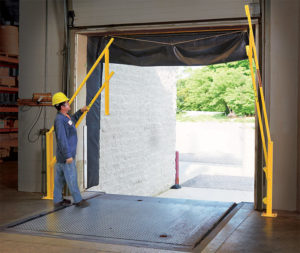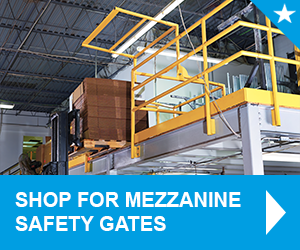
In a warehouse environment, there are many hazards that workers are exposed to as they perform their duties. Loading docks, stairways, ladders, forklift paths, and walkways can all be dangerous, but they’re hardly the only hazards. Many warehouses utilize mezzanines and elevated platforms to store equipment, materials, and supplies since growing upwards is more efficient than expanding the warehouse’s footprint. These platforms represent a potential falling hazard, both for workers on the platform as well as those working below.
Warehouse safety procedures are essential to ensure workers are protected from danger. To facilitate this, it’s vital that warehouse managers identify the most common hazards and then provide workers with OSHA approved fall protection devices such as a mezzanine gate, platform gates, guardrails, and personal fall protection devices.
What’s more—it’s the law. OSHA standard 1910.28, Duty to Have Fall Protection, states that: “the employer must ensure that each employee on a walking-working surface with an unprotected side or edge that is 4 feet or more above a lower level shall be protected from falling by guardrail systems, safety net systems, or personal fall arrest systems.”
Passive and Active Fall Protection
Warehouse safety is a complicated process and it’s up to employers to find the best fall protection for their circumstances. In most cases, it is recommended that mezzanines and other elevated surfaces are protected with passive fall protection such as guardrails and mezzanine safety gates. However, if it is not possible for these devices to be used, active fall protection equipment such as a full body harness and lanyard attached to a secure anchor point are required.
Mezzanine and Elevated Work Surface Hazards

- Workers falling over the edge onto the surface below
- Workers falling on or into machinery
- Equipment and tools falling over the edge
- Workers being injured by falling debris, tools, and equipment
In addition to a mezzanine gate or other passive fall protection or fall arrest device, workers may also require personal fall protection such as a lifeline, harness, and lanyard. While these devices will not necessarily stop a fall from happening, they do limit the distance a worker can fall and thus protect them from serious injury.
Elevated Walkways
Another common warehouse safety concern is elevated walkways that workers must traverse to get from one section of the warehouse to another. If a worker is carrying tools, equipment, or other materials in their arms, they may not be able to see the walkway’s surface. Likewise, if the walkway isn’t well-lit, it becomes difficult to see any possible trip hazards. In either case, a worker can fall to one side or the other unless there is a sturdy guardrail in place. Additional protection such as a safety line further prevents employees from experiencing a fall from an elevated walkway.
Forklifts and Other Equipment
Oftentimes, it is necessary to use equipment such as a forklift to place pallets and other materials onto a mezzanine or elevated platform. The same equipment is then used to retrieve these materials when needed. Whenever this occurs, an opening must be maintained so the materials can easily be transferred. To protect workers from falling through this opening, employers must install OSHA-approved platform gates or similar fall protection systems. In addition, forklift and other heavy equipment operators must be trained on their safe operation and the proper use of fall safety devices.
Ground Level Hazards
The majority of the work that’s performed in a warehouse may be at ground level, but that doesn’t mean there aren’t any hazards present. If tools, equipment, machinery, materials, or debris fall from a mezzanine, platform, or elevated walkway, it could strike a person below and cause serious injury. Guardrails, platform gates, a mezzanine gate, and netting help prevent these mishaps and keep workers safe. Additional protection such as a hard hat, safety goggles, and warning signs further ensure the safety of workers at ground level.
Loading Dock Hazards

- Slippery, wet, or oily surfaces
- Broken or uneven surfaces
- Unprotected dock edges
- Unsecured dock plates
- Forklifts and other vehicles
Eliminating these issues involves keeping loading dock floors clean and free of debris, installing safety railings and loading dock safety gates, painting brightly colored warning strips along edges, and incorporating warning lights and sirens workers can easily see and hear.
Authorized Personnel Only
Even if an employer provides their warehouse workers with personal fall safety devices, has installed mezzanine safety gates, guardrails, and other passive fall protection, it may not be enough. Restricting access to dangerous mezzanine areas to authorized personnel is imperative. These employees will understand how dangerous the situation can be and are trained to safely perform their jobs, while an untrained employee may not. Install safety gates and other barriers to deter unauthorized entry and to ensure only authorized individuals enter these areas.
OSHA’s requirements for warehouse safety are strict and any facility that fails to comply with the rules will face stiff fines and other punishments. But compliance isn’t the only reason to provide your warehouse workers with the fall protection devices they need to work safely. When safety is a priority for leadership, it becomes part of the company culture and workers take on a safety-first mentality and encourage it in others. And fewer injuries due to falls improves the company’s image and increases the bottom line by reducing expenses associated with these preventable accidents.










